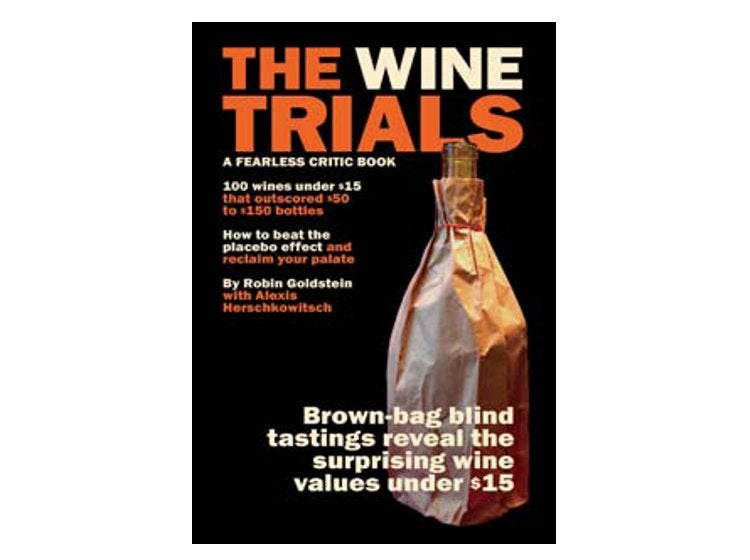
Robin Goldstein with Alexis Herschkowitsch
The Wine Trials
Published by Fearless Critic Media $14.95/£10
Reviewed by Stuart George
Fearless Critic was founded in 2003 by Robin Goldstein and Alexis Herschkowitsch as a series of restaurant guides that became infamous for their harsh ratings. In 2008, Goldstein gained some notoriety by winning a Wine Spectator Award of Excellence for a restaurant that didn’t exist.
The punchy cover line-“How to beat the placebo effect and reclaim your palate”-gives an idea of what to expect inside: forceful summaries of various topics that the wine industry apparently fails to confront, such as blind tasting, ad money from producers that are reviewed and scored, the arbitrariness of most wine pricing, restaurant markups, and so on. But the raison d’être of the book is to assess 100 wines under $15 that “beat” $50-150 bottles in the authors’ blind tastings, in which 507 tasters-some professional, some not-participated and rated 560 different wines. There was even a “scientific advisory board” to “interpret our results, and review our methods and conclusions for scientific accuracy” (p.VI). Unlike the restaurants, however, the wines are not scored. Blind tasting is repeatedly championed (pp.5 and 28), but “Wine should not always be experienced blind” (p.29; his italics, which are used repeatedly for emphasis) because, as Goldstein rightly points out, “wine has never had a single style or single purpose. Is it meant to be served before dinner, during dinner, or with dessert?”.
LVMH-and in particular its leading brand, Dom Pérignon-is given short shrift, damned as a mere money-making machine. Indeed, DP is the only “expensive wine” to have its assessment published, and it is soundly trashed: “Drink with people who are impressed by expensive things [… T]he pompous label maximizes the placebo effect. Why donate $150 to help float LVMH’s ostentatious marketing budget?”. For Goldstein, it is “un-American” to buy a wine, or anything else for that matter, on the reputation of a brand alone. But rather revealingly, the “experts” liked DP, apparently, even if they didn’t think it was worth $150.
Unfortunately, we don’t know what the other $50+ bottles were, and this does undermine slightly the claims of the 100 sub-$15 wines that appear here in one-page profiles. But Goldstein’s main point is that, “people actually preferred the cheaper wines to the more expensive wines- by a statistically significant margin”. In the tastings, Australia fared relatively poorly, rosé wines even worse, but France and Iberia showed strongly.
Goldstein notes that high scores in The Wine Advocate and Wine Spectator are closely correlated with high prices. The wines are often tasted blind, so “the most obvious explanation […] would be that expensive wine is simply an acquired taste, and that the vast majority of wine drinkers […] just haven’t acquired the taste the way that these magazines’ elite tasters have”. As Goldstein notes dryly, “it’s not quite impossible- just statistically improbable-that Spectator critics are among the only people on Earth with perfect palates”.
Sometimes the book is quite disingenuous, as polemics often are. There are lots of questions-Chapter 5 is even called “So What?” – but rather fewer answers. Moreover, judging a wine by its label cuts both ways, of course, and this book champions an inverted snobbery, whereby anything expensive must be bad or at least bad value.
On the whole, however, the book is intelligent, punchily written, and, indeed, as fearless as it proudly proclaims. It is not as relentlessly curmudgeonly as Malcolm Gluck’s Great Wine Scandal. But perhaps US wine writing needs something like this- that is, somebody to give a straight answer to consumers who might be less well informed and who are probably less well off than those who typically read The Wine Advocate or Wine Spectator, and somebody to challenge the hegemony of those titles.






